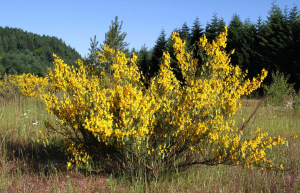
By Bob Wadsworth – When the city purchased the two parcels in south Olympia that became the LBA Woods Park in 2016 and 2017, they set aside a 10-acre portion with designs to develop it for housing and small businesses. This parcel is located to the southwest of the Park adjacent to Boulevard Road and 41st Way (at 3900 Boulevard Rd). And has been referred to as the scotchbroom or more accurately the shrubland parcel.
Now, the city has begun the process to select a developer for the 10-acre site.This process, a Request for Qualifications (RFQ), was first discussed at the September 19 meeting of the City of Olympia Land Use and Environment Committee. The timetable is very short and includes contractor responses due on October 21and final selection on December 4.
This process was initiated with no opportunity for prior public to comment, though providing an opportunity for public comment was discussed at an earlier date. There is a very narrow window for comment, but you can direct comments to the Olympia City Council members who are members of the Land Use and Environment Committee:
Clark Gilman (Chair) cgilman@ci.olympia.wa.us
Lisa Parshley lparshle@ci.olympia.wa.us
Nathaniel Jones njones@ci.olympia.wa.us
Your comments might address the lack of an advanced public review of possible directions for handling this project, the need for habitat suitable for migratory birds, the short sightedness of clearing wildlife habitat for urban uses when there are other sites within other urban areas that could be developed, the impact of new development on nearby traffic and infrastructure, the additional population pressure on the adjacent LBA Woods, or the need to verify the presence of Mazama Pocket Gophers.
I have spent the past 20 years walking and birding the trails of the LBA Woods, and after the park was established, volunteer as a steward with the City of Olympia Parks Department. One of the biggest surprises for me was to discover the richness of bird life in this 10-acre shrubland.At first glance the site appeared to be a scotchbroom and blackberry wasteland, but as I began to realize the richness of its bird life, I began to understand why the great bird diversity. One strong reason is the many mature shrub species producing fruits and berries that could feed birds in all seasons. It has taken many years to develop this diverse shrubland, and would take a long time to produce again if cleared.
The site has a great number of elderberry, crab apple, and cascara shrubs, all of which produce berries during the spring, summer and fall, with many carrying over into the winter.
Since I and others have recorded birds at the 160-acre LBA woods, the tally is now up to 81 species. For the 10-acre shrubland, the tally is 38 species, which is almost 50% of those found in the entire LBA Woods.The site attracts many migrant birdspecies including 6 in the winter and 13 summer nesters. These are in addition to 20 year-round residents.
The species list includes:
- Winter migrants — golden crown and ruby crown kinglets, varied thrush, golden crown and fox sparrows and red crossbill
- Summer migrants — California quail, band tailed pigeon, Vaux’s swift, rufous hummingbird, willow flycatcher, tree, violet green and barn swallow, Swainson’s thrush, orange-crowned and yellow-rumped warblers, western tanager, black headed grosbeak
- Year-round residents — Eurasian collared dove, mourning dove, anna’s hummingbird, red tailed hawk, northern flicker, willow flycatcher, Steller’s jay, California scrub jay, American crow, black capped and chestnut-backed chickadee, bushtit, red-breasted nuthatch, Bewick’s wren, American robin, house finch, American goldfinch, dark-eyed junco, song sparrow, spotted towhee.
- The site supports flocks of 50 or more bandtail pigeons (the native pigeon closely related to the extinct passenger pigeon), nesting red tailed hawks (two young birds fledged this year), goldfinches, the colorful western tanager and black headed grosbeak, and the spectacular California quail.
- There may be Mazama pocket gophers, since the open shrub-grass habitat may serve their needs and other colonies are in nearby areas. Suspected presence of the pocket gopher requires a County verification of their presence and, if found, developing mitigation steps, which can significantly affect development projects.
This 10-acre parcel is a bird life treasure that rewards those who visit every day of the year. It provides a unique habitat for birds at a time when statistics show that bird populations are declining.
There is still a short time left to send your comments to the Land Use and Environment Committee to keep the bulldozers away.

